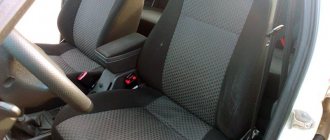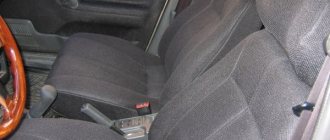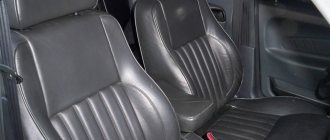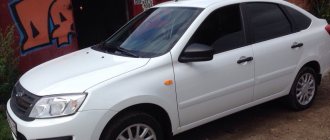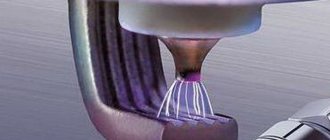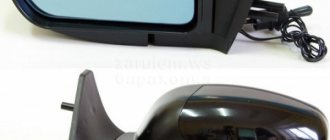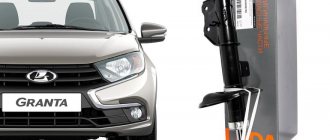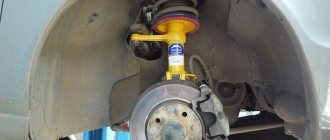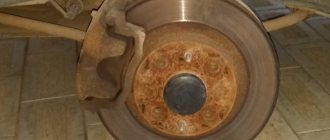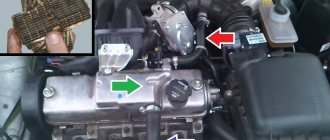Lighting
The interior lighting of the Lada Kalina leaves much to be desired. Only the front part of the car is equipped with a small lamp. The rear area of the cabin does not have any lighting devices. According to numerous reviews, tuning the interior of the Lada-Kalina hatchback includes installing a rear row light, which an LED strip will help with. You can connect it to the front lamp, and hide the wiring under the ceiling card. For convenience, you can mount a separate switch in the rear row area. Thanks to this, passengers have the opportunity to turn it on themselves if necessary.
How to take up trunk space
In Kalina-2, as in most other hatchbacks and station wagons, the trunk and interior are separated by a removable shelf. This shelf can be dismantled, or you can use it to install speakers. True, then there will be little space left for the subwoofer, especially if we are talking about a hatchback:
Subwoofer housing in the trunk of a hatchback
Everything looks great in the station wagon, especially if the shelf has been removed:
Homemade subwoofer housing in the trunk of a station wagon
The amplifier in both cases is mounted on the back of the rear seat. In fact, it is not recommended to do this - the cladding elements are not designed for significant loads.
Torpedo
The dashboard is considered one of the important elements of the interior. For tuning the interior of Lada-Kalina, two main options are used. The first, which costs a budget, is to buy a special panel trim and attach it over the standard dashboard. This option is considered inexpensive because during its installation it may be difficult to select the exact dimensions. Therefore, the overlay will have to be trimmed a little. This is a rather complex and difficult process, which, if done incorrectly, can completely ruin the appearance of the salon. The second option is to purchase a completely new dashboard. In this case, installation will not take much time. However, you will need to spend a lot of money.
Body
In principle, Lada Kalina 2 is released from the factory with tuned bumpers, which perfectly complement its appearance. Therefore, there is no point in changing them. To improve the appearance, you can install more elegant rims. You can choose not only a different disc design, but also a slightly larger size.
On some station wagon bodies, a spoiler is installed. Of course, some problems may arise with its installation. This is due to the vertical position of the trunk lid. Unlike this body, the Kalina hatchback has a trunk lid cut at a slight angle, which facilitates the normal installation of the spoiler. Such tuning does not bring any improvements other than visual ones.
Station wagon tuning
The next part that can be changed is the optics. Many people, by the phrase “tuning headlights,” mean installing xenon instead of the standard halogen. But the improvement does not necessarily have to be exactly like this. It is enough to simply darken the glass of the front and rear headlights with varnish. The main thing in this matter is not to overdo it.
Cover trims
If sticking special decorative trims on the dashboard does not seem enough, you can dismantle the plastic door trim yourself and improve it. For example, tuning the interior of a Lada Kalina, which imitates natural materials, always looks impressive and attractive. After removing the trim of the standard parts, cover its elements with durable vinyl or carbolic film. After the material is glued, all parts are assembled strictly in the reverse order. Most often, car enthusiasts use film with a pattern similar to the texture of wood. Let us remind you that special pads can be mounted on parts of the speaker system housing.
To do the work yourself, you will need a stationery knife, scissors and the material itself. Experts advise sticking the film directly onto the plastic.
Pre-mark the places where the holes for the buttons will be located. To do this, use a paper stencil. For convenience, remove the plastic panel. After you cut out the pattern, clean the plastic parts and degrease their surface. Only after this can the film be applied.
The use of carpet and leatherette
Need a simple tuning option - please. Try fixing the fabric, called “carpet”, to the inner surface of the glove compartment:
The glove box of Kalina-2 is covered with carpet
If everything works out, the same material will be used to cover the door pockets and individual trim elements:
Refinement of door trim
The carpet sheet is held on the plastic with glue. The necessary materials are available at parts stores. By the way, instead of carpet you can use leatherette. We will leave the choice to the owner.
Armchairs
Of course, the seats in a car are not the first thing passengers pay attention to. And tuning the Lada-Kalina's cabin will be incomplete if the seats are not improved or completely replaced. The main disadvantages of the Lada-Kalina seats are the short bottom cushion and the lack of lateral support.
To eliminate these shortcomings, it is better to contact a specialized studio to rebuild the standard shape of the chairs. The second way to tune a Lada Kalina is to select a more suitable seat option from another car. Installing new seats is considered more acceptable due to the amount of money that is spent. In fact, specialist tailors will charge large sums of money for their services. But if you're lucky enough to find seats that suit you best, you can redo the fastenings yourself.
Solving the problem when the stove on the Lada Viburnum does not heat well
With the onset of cold weather, many car enthusiasts notice that the stove on the Lada Kalina does not heat up. The malfunction can be in different elements of the system and sometimes it is not easy to determine the cause. Let's try to figure out in detail how to determine the cause of the malfunction, and then repair the Lada Kalina stove with your own hands.
Checking the ventilation and heating system fan:
- We set the air temperature regulator knob on the control unit to the extreme position of the blue sector.
- We alternately switch the fan speed knob, starting with the first speed and ending with the fourth.
- We check the intensity of the air flow coming from the air ducts. It should get stronger with each switch.
If the heater does not work on the Lada Kalina, check the integrity of fuse F5, as well as its power circuit. If the fan does not operate in all modes, or the air flow intensity does not change linearly, check the additional resistor and switch. If the air flow is weak, replace the cabin air filter.
Checking the heater dampers:
- Set the temperature regulator to the extreme position of the blue sector, and the fan speed to maximum.
- We turn the damper control knob on the block and at the same time monitor changes in the directions of air flows.
Unchangeable air flows indicate a malfunction of the mechanical heater control unit (the draft has flown off, or does not screw onto the roller due to its breakdown), or the damper is jammed. If the car uses climate control, then check the damper micromotor and the ventilation, heater and air conditioning control unit.
- Warm up the engine to operating temperature.
- Turn the air temperature regulator to the extreme position of the red sector.
- Warm or hot air should come out of the air ducts
If the air temperature has not changed, check the serviceability of the mechanical heater control unit (the rod has come off, or does not screw onto the roller due to its breakdown), or the damper is jammed. If the car uses climate control, then check the damper micromotor and the ventilation, heater and air conditioning control unit. Make sure the engine cooling system is working properly.
The interior temperature sensor is installed in the lampshade on cars equipped with a climate control system. Most often, a sensor malfunction can be determined by the operating mode of the stove. If only hot or cold air blows from the panel nozzles, regardless of the position of the handle on the heater control unit, then most likely the ceiling air sensor has failed.
Have you noticed that the heater on the Lada Kalina blows cold? Proceed according to the scheme “from simple to complex”, first check the simplest elements of the heating and ventilation system, for example, the air filter and the presence of coolant. Then gradually move on to more complex design details.
Novaya Lada: Oh!
Another good way to find out which part has failed is to replace it with a known working one and check the operation of the system. And you don’t have to buy a new spare part if you borrow it from a friend. You can also try to negotiate with the seller in the store, take a new part for testing, leaving a deposit.
According to the results of the survey “Why does the stove on the Lada Kalina not heat well?” The main causes of the malfunction were identified:
- 32% voted for problems with the heater damper.
- 14% of votes were given for a faulty heater fan.
- The same number of votes (13%) were given for a failed ventilation and heating system control unit and a faulty heater radiator (replacement).
- For 9% of survey participants, the fault in the heater’s malfunction was the damper’s micromotor reducer.
The remaining votes were given for other problems with the Lada Kalina stove: a faulty additional resistor for the stove, a cabin temperature sensor and a dirty cabin filter.
Let us remind you that you can find various modifications to the car systems in the Lada Kalina tuning section.
The car's heating system must be in good working order regardless of the time of year. But many people think about this only when cold weather sets in. The efficient operation of the Lada Kalina heater ensures a comfortable stay in the cabin. The heating system does not fail so often, but timely maintenance is also important for it.
The heater in a car transfers heat from the engine to the cabin. Without heating, the windows quickly fog up and become frosty in winter. On Kalina, the location of the stove allows for the possibility of integrating an air conditioner. The system is designed extremely simply and clearly, and is the same for models regardless of body type - station wagon, sedan or hatchback. It is shown schematically in the photo.
Heating system diagram
- The air duct exit is on the left.
- Air duct on the left.
- Windshield air ducts.
- Air duct distribution housing.
- Heater.
- Ventilation duct on the right.
- The air duct exit is on the right.
- Air duct for heating feet.
- Air duct for heating the interior.
- The air duct outlet is in the center.
The design uses the supply and exhaust circulation principle. Air enters the cabin, heated by the coolant, which simultaneously removes excess heat from the engine. The stove operates as a result of the radiator being heated by coolant. Then, with the help of a fan, the heated air flows through the air ducts through the deflectors into the car interior.
The heater control unit consists of the following elements:
- Temperature regulator. By turning the knob, you can adjust the temperature of the air entering the cabin. Turning to the blue zone adds cold air, turning to the red zone adds hot air.
- Fan speed switch. It regulates the speed of air flow into the cabin.
- Air flow direction switch - to the windshield and down, only down to the feet, to the upper part of the cabin, to the windshield and side windows.
- Recirculation handle. Enables air circulation inside the cabin, while no air enters from outside. Can be used for a short time due to fogging of windows.
- Rear window defogger.
New Lada: Why the production Lada XRAY is not similar to the 2012 concept car
The control system also includes air duct deflectors. They can be closed or opened, and can also be used to regulate the direction of air flow.
The most common malfunctions of the stove are that the air flow is weak, only cold air comes in or not at all. Among the reasons why the stove on the Lada Kalina does not heat:
- Wear of the engine cooling system pipes. Antifreeze leakage due to worn hoses leads to a decrease in its level in the system, and therefore to insufficient heating of the heater radiator.
- The stove valve is out of order. This malfunction can be determined by the puddles of coolant that appear on the floor, under the front mats.
- The heating control unit is faulty. First, you should check the power supply from the on-board network. If it arrives, there is a problem in the air conditioning system. It is better to entrust unit repair to specialists.
- Wiring problems. There is no voltage supplied to the heating control unit. To check this, you will have to “ring” all sections of the chain.
- The additional resistor used to control the electric fan is faulty.
- The heater regulator is broken. In this case, it will be impossible to set a comfortable air temperature in the cabin.
- The radiator is faulty. One of the most common problems is that the Lada Kalina stove does not heat well. In the event of a breakdown, coolant leaks are typical. The part cannot be repaired.
If the problem is not heating, the cause is a malfunction of some part of the cooling system. These two systems are interconnected, and problems with one negatively affect the other.
The first sign that something is wrong with the cooling system is a decrease in the level of antifreeze in the expansion tank. The amount of coolant should be constantly monitored. In a working system, its level should be maintained between the minimum and maximum marks. If the amount of antifreeze begins to decrease, the engine will heat up faster and the risk of overheating will increase.
Steering wheel
Not every car enthusiast likes the standard Lada-Kalina steering wheel. Therefore, they very often want to replace it with a more stylish and convenient one. One of the options for tuning the interior of the Lada Kalina sedan is to install a sports steering wheel. This original upgrade has many advantages: the car’s interior will become more interesting, and most importantly, the updated sports steering wheel, thanks to its aggressive appearance, will allow the driver to feel much more confident on the road. But in order to easily and without problems mount a new steering wheel on the Lada-Kalina, you will need a special adapter.
LED Strip Light
In addition, an excellent addition to all of the above tuning options to complete the interior improvement picture is to install new lighting around the entire perimeter of the cabin. To do this, you will need to lay a diode strip of the desired color (or different shades) and connect it to a standard battery, that is, the on-board network. Additional lighting due to the LED strip will give the interior an attractive appearance and highlight all the changes made.
The following tuning of the Lada-Kalina interior is carried out with your own hands:
- Installing a diode strip around the perimeter of the car allows you to provide additional lighting for literally the entire interior. The brightness and shade of the backlight directly depend on the LEDs you have selected. This lighting option allows you to increase illumination by an average of two or even more times. If necessary, you can install separate ribbon inserts into the roof of the cabin, and it is quite possible to create the effect of a “starry sky”.
- Attaching an LED strip to the elements of the front dashboard, in its lower part, allows you to additionally illuminate the areas at the feet of the driver and passengers. This tuning will increase the comfort of being in the car.
- Also, in some situations, the LED strip is mounted on the car body. Most often, such lighting is used as auxiliary or even main running lights. However, such tapes are often exposed to external mechanical influences from the environment, which is why they can quickly fail.
If you want to become the happy owner of an original and stylish car and proudly drive on the roads, tuning will help you with this. Such improvements will help improve not only the appearance of the machine, but also increase its efficiency. You are guaranteed the envious glances of all surrounding car owners!
Interior ventilation controls for Lada-Kalina
Levers 9 and 5 of the damper drive regulate the intensity of air supply through the side (8) and central (4) nozzles by changing the position of the dampers (up to their complete closure). Levers 1 and 3 of the guide vanes of the side and central nozzles change the direction of the air flow.
Ventilation (supply of unheated air) of the interior.
- set switch 2 to the extreme left position (blue dot on the control unit) - the heating stove faucet is completely closed;
- set switch 4 to the horizontal right position;
- open nozzles 4 and 8, turn lever 5 on the central nozzle down, and lever 9 to the right on the left side nozzle and to the left on the right side nozzle;
- Set heater fan operating mode switch 1 to the desired mode;
- If the windshield fogs up, set switch 4 to the vertical upward position.
Preventing glass fogging.
- set switch 2 to the extreme right position (red dot) - the heating stove faucet is completely open;
- set switch 4 to the vertical position up;
- Set switch 1 of the heater fan operating modes to position “2”.
Quick heating of the interior.
- set switch 2 to the extreme right position (red dot) - the heating stove faucet is completely open;
- set switch 4 to the horizontal position to the right;
- Set switch 1 of the heater fan operating modes to position “3”;
- open the side and central nozzles.
Ensuring a comfortable temperature in the cabin.
- set switch 2 to the required position (desired temperature);
- set switch 4 to the horizontal position to the left;
- Use switch 1 of the operating mode of the interior heater fan to select the required intensity of warm air supply to the interior.
When the heating system is operating at maximum mode, it is not recommended to open the car interior windows.
Outside air can enter the cabin through the door windows when the windows are down and the air intake located in front of the windshield on the right and equipped with a dust filter that cleans the air from dust, soot, pollen, etc. The air entering the cabin through the intake passes through the heater.
The location of the air current distribution organs is shown in Fig. 1.11, the location of the heater and ventilation controls is in Fig. 1.12.
The flow distribution organs are located on the instrument panel
1 - air supply ducts for passengers in the rear seat
2 - side nozzles for supplying air to the driver and passenger on the front door or on the windows of the front doors. The air flow is controlled by grilles (in the vertical direction and flaps in the horizontal direction)
